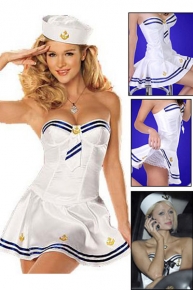Fashion Dress – From Couture Beginnings to Mid-Twentieth Century
The first fashion designer who was not merely a dressmaker was Charles Frederick Worth (1826-1895.) Before the former draper set up his couture fashion house in Paris, fashion creation and inspiration was handled by largely unknown people, and high fashion descended from style worn at royal courts. Worth’s success was such that he was able to dictate to his customers what they should wear, instead of following their lead as earlier dressmakers had done.
It was during this period that many design houses began to hire artist to sketch or paint designs for garments. The images alone could be presented to clients much more cheaply than by producing an actual sample garment in the workroom. If the client liked the design, they ordered it and the resulting garment made money for the house. Thus, the tradition of designers sketching out garments designs instead of presenting completed garments on models to customers began as an economy.
Around the start of the twentieth century fashion style magazines began to include photographs and became even more influential than in the past. In cities throughout the world these magazines were greatly sought-after and had a profound effect on public taste. The outfits worn by the fashionable women were strikingly similar to those worn in the heyday of the fashion pioneer Charles Worn, By the end of the nineteenth century, the horizons of the fashion industry had generally broadened, partly due to the more mobile and independent lifestyle many well-off women were beginning to adopt and the practical clothes demanded. The constant need for radical change, which is now essential for the survival of fashion within the present system, was still literally unthinkable.
During the early years of the 1910s the fashionable silhouette became much more lithe, fluid and soft then in the 1900s. Paul Poiret also devised the first outfit which women could put on without the help of a maid. Simple felt hats, turbans, and clouds of tulle replaced the styles of headgear popular in the 1900s. It is also notable that the first real fashion shows were organized during this period in time, by the first female couturier, Jeanne Psquin.